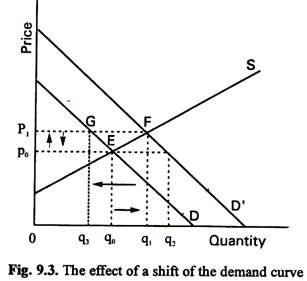The Myth of Economics
Posted on October 17, 2019Economics. The fabled art of money moves and Fox News spotlights. Talking heads who argue back and forth about GDP and “economic growth” and either laud or bemoan capitalism. But what are we talking about when we say Economics? And how does the way we talk about it affect the structure of Economics in and of itself? I argue that because the way we talk about Economics is rooted in a dominant design paradigm, we are limiting ourselves in our ability to envision new models outside of or evolved beyond it.
In our current moment, we understand economics as the following:

[image of system and demand model]
As Koray Caliskan has demonstrated, this is an ontological impossibility. [1] It is not naturally possible to simultaneously demonstrate supply and demand except by design. We have chosen to purposefully design our boundaries of economics as such so that we may better understand it. But these are artificial boundaries. And as Donella Medows points out, “… boundaries can produce problems when we forget that we’ve artificially created them…” [2; p97] Boundary drawing is political. And those who have drawn those boundaries tend have done so through the dominant design paradigm as defined by Daniela Rosner. It is solutionist – economic models are posited as methods of understanding what is going on in the present and offering solutions for the future; it is individualist – in that based in Adam Smith’s underpinning of formalism, where the economy is a reflection of undesigned aggregated individual actions; it is objective – in that we assume that mathematical models are objective and neutral and based in natural truth, which is has been proven to be situated [3] and biased [4]; and it is universalist – in that economics can be considered a way of “proposing a ubiquitous relationship between humans, animals and machines and developing a unified description of behavior.” [5; p32]
The way we visualize economics in all its ontological impossibility keeps us from being able to envision new models. Because we have forced ourselves to only speak within this dominant design paradigm, we are missing crucial pieces of the story. Economics is not just lines and numbers and diagrams. “Remember, always, that everything you know, and everything everyone knows, is only a model.” [2; p172] We have forgotten that models are simply ways of talking about things, not its entire essence. The way we diagram and design economics is too systematic and mechanistic for how messy the flows of money are within our system. They are flawed stories and metaphors. Don’t get me wrong. I’m no positivist. I fully believe that the language – both narrative and visual – that we utilize when talking about economics is integral to how economics functions. These metaphors are studies of performativity – if you’re talking to Judith Butler [6] – or performativity thesis – if you’re talking to Michel Callon [7]. Regardless of who you choose to talk to, this means that the metaphors, stories, and diagrams we use to explain economics become the structure which births and creates a framework within which to talk about economics itself. What does that mean? It means that because we choose to talk about economics through mathematical models and 2d visual diagrams rooted in a singular snapshot of time, our understanding and dialectic of economics is also mathematical and similarly artificially stuck in time. But economics is fluid. It is a product of time and history and space. It is a narrative about societal and political priorities and values that are imagined by people and materialized in money. Human beings cannot be quantified and it is a rejection of the tangled mess of politics, intuition, systemic forces, free will, and cultural narrative that drive human beings to imagine that we can distill an entire country down to something as absurdly simplistic as its Gross Domestic Product. What a massive disservice Economists are doing to economics. We should demand better.
In an effort not to end on complete negativity, I do believe there might be a path forward through the lens of justice and embodiment. I suspect there is something to be said for expanding our economic models to encapsulate time through a lens of just transition that is fully cognizant of the legacy of colonialism and situated cultural shifts throughout time. I also believe that there is a path forward in embodied economics. There is something in the way our bodies can express complexities situated in space and time that cannot be condensed into diagrammatic models. Perhaps there is a future there.
– A. Lathrop
References:
[1] Caliskan, K. (2019). New Economies.
[2] Meadows, D. and Wright, D. (2008). Thinking in systems. 1st ed. London: Earthscan.
[3] Haraway, D. (1988). Situated Knowledges: The Science Question in Feminism and the Privilege of Partial Perspective. Feminist Studies, 14(3), p.575.
[4] Gulker, M. (2019). Why Bias Will Always Be a Part of Economics. [online] AIER. Available at: https://aier.org/article/why-bias-will-always-be-a-part-of-economics/ [Accessed 18 Oct. 2019].
[5] Rosner, D. (2018). Critical Fabulations. Cambridge, MA: The MIT Press.
[6] Butler, J. (1988). Performative Acts and Gender Constitution: An Essay in Phenomenology and Feminist Theory. Theatre Journal, 40(4), p.519.
[7] Kieran Healy (2015). The Performativity of Networks. European Journal of Sociology, 56, pp 175-205 doi:10.1017/S0003975615000107